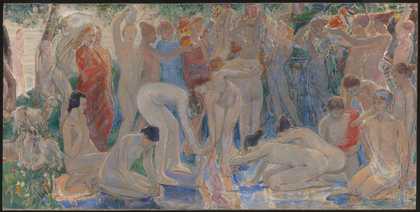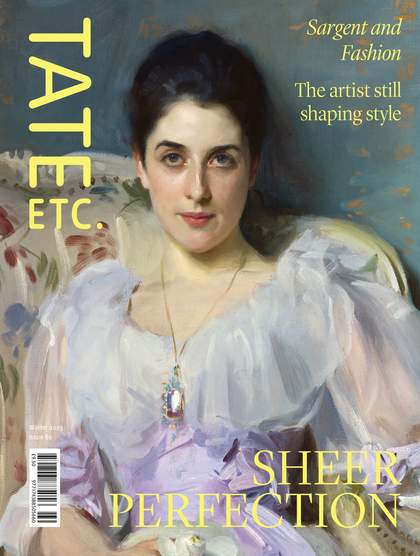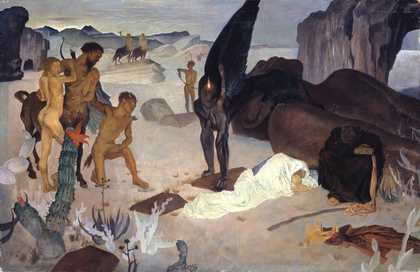
Dame Ethel Walker
Decoration: The Excursion of Nausicaa (1920)
Tate
‘I am going to be painted, stark naked, by a woman called Ethel Walker’, Virginia Woolf wrote to Vita Sackville-West in 1933; she ‘says I am the image of Lilith’. In a footnote, the editors of Volume V of The Letters of Virginia Woolf touch on the three mysteries thereby evoked: what sort of painter would make such a charmingly bold proposal to Virginia Woolf? Who is Lilith? And, most urgently, where can we see this painting?
That painting was never realised, the editors report, although by 1933 Ethel Walker was a respected artist, the first woman allowed to join the New English Art Club, her work already shown twice at the Venice Biennale. In 1937 she painted a portrait of the artist Vanessa Bell, Woolf ’s sister, and in 1943 she was made a Dame. She was an artist willing to take up an entire wall with one of the huge oil paintings that she called ‘Decorations’, even stretching her own canvases if necessary. And Lilith? According to the footnote, Lilith was an ancient ‘Assyrian-Jewish demon’ – an identity perhaps difficult to reconcile with Woolf ’s, until we remember that she once declared herself that she was ‘born many thousands of years ago; and had from the very first to encounter instincts already acquired by thousands of ancestresses in the past.’
The Lilith that Walker did sketch in c.1916 is naked but not stark: tall, fluid, the lines of her body twisted handsomely at knees and waist, her hands plunged into her hair, gazing into the distance. She does not look like a demon but a dancer – Walker went to the ballet nearly every week – and, more importantly, like a woman whose nude body is not primarily an object of religious moralising or a prurient male gaze. Figures like Lilith echo through Walker’s paintings, from The Bathers c.1910–20 to Decoration: The Excursion of Nausicaa 1920. In these paintings there are ensembles of women – figures half-clad or naked, collectively absorbed or contemplative. There are the women, bathing; there is the water, lightly giving back their reflections.

Dame Ethel Walker
Lilith (?exhibited 1916)
Tate
The Excursion features duets and triads of figures making gestures that ripple between bodies: kneeling, bending to the water, bearing an urn or a spray of flowers overhead, turning, pouring, reaching. The bodies of women take up almost all the space, which is a striking choice, given that Princess Nausicaa, from Book VI of the Odyssey, is generally seen in terms of her use-value for Odysseus. Nausicaa’s excursion to the river is a narrative excuse for Odysseus – the hero, the one whose name stamps the story in his image – to get himself invited back to the castle, where he can recount his woes to the king. But in this painting, Walker has relegated him to the sidelines. Odysseus is a slightly pathetic figure on the far left, peering out from behind a tree, diminished in relation even to the goats. Nausicaa and the women washing with her are, for this moment, the centre of the story.
In her seven decades, Walker had, no doubt, acquired the instincts of those ancestresses who, like Nausicaa, might be given a bit part in the hero’s epic or the art history canon if they were lucky. When Virginia Woolf wrote to Vita Sackville-West of Walker’s proposal, she noted that the artist was 73 and lived alone, in one room by the river. Woolf sketches an endearing portrait of Walker: her ‘rough raddled charm’, how the swans and lorries go by under her window, how she ‘has lived a regular herring griller’s life’. Although Virginia Woolf was never painted by Ethel Walker, here she creates an image of a woman in her own space by a river, who created images of women in their own space by a river: an excursion, an homage, a sympathy, a summoning.
Decoration: The Excursion of Nausicaa is on display at Tate Britain until 6 May 2024. Decoration and Two Figures, Study for ‘The Excursion of Nausicaa’ were purchased in 1924.
Selby Wynn Schwartz is the author of After Sappho, published by Galley Beggar Press, which was longlisted for the Booker Prize in 2022.



